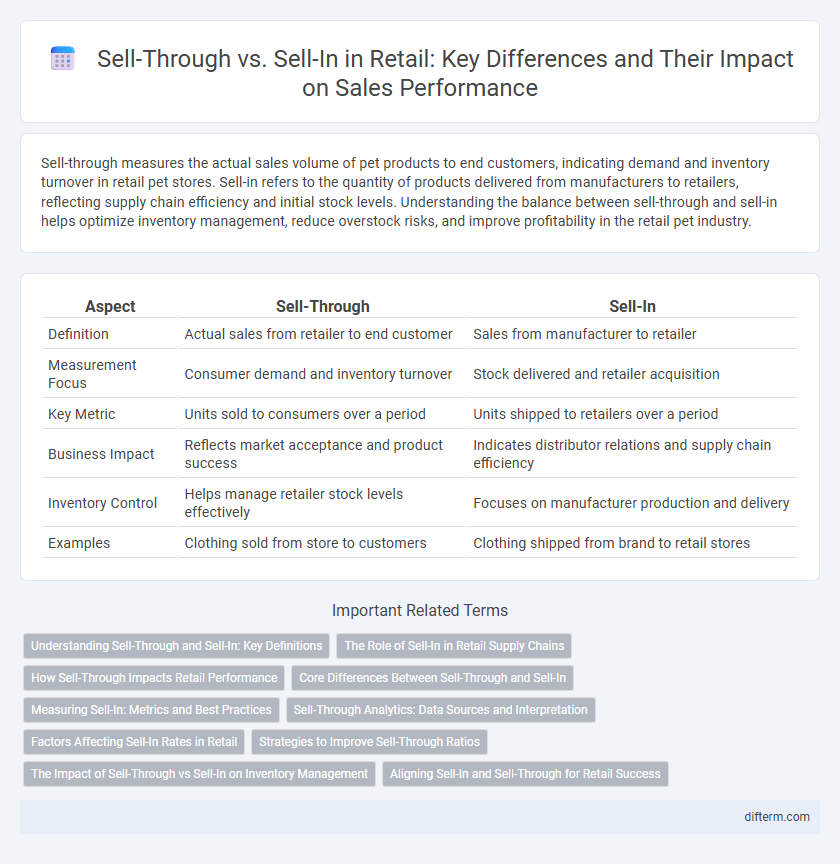Sell-through measures the actual sales volume of pet products to end customers, indicating demand and inventory turnover in retail pet stores. Sell-in refers to the quantity of products delivered from manufacturers to retailers, reflecting supply chain efficiency and initial stock levels. Understanding the balance between sell-through and sell-in helps optimize inventory management, reduce overstock risks, and improve profitability in the retail pet industry.
Table of Comparison
| Aspect | Sell-Through | Sell-In |
|---|---|---|
| Definition | Actual sales from retailer to end customer | Sales from manufacturer to retailer |
| Measurement Focus | Consumer demand and inventory turnover | Stock delivered and retailer acquisition |
| Key Metric | Units sold to consumers over a period | Units shipped to retailers over a period |
| Business Impact | Reflects market acceptance and product success | Indicates distributor relations and supply chain efficiency |
| Inventory Control | Helps manage retailer stock levels effectively | Focuses on manufacturer production and delivery |
| Examples | Clothing sold from store to customers | Clothing shipped from brand to retail stores |
Understanding Sell-Through and Sell-In: Key Definitions
Sell-through measures the percentage of inventory sold to customers compared to the stock received by retailers, reflecting actual consumer demand and inventory turnover efficiency. Sell-in refers to the quantity of products shipped from manufacturers to retailers, indicating supply chain activity and initial stock placement. Understanding the distinction helps optimize inventory management, avoid overstocking, and align production with market demand in retail operations.
The Role of Sell-In in Retail Supply Chains
Sell-in represents the volume of products that manufacturers or suppliers deliver to retailers, serving as a key indicator of initial stock availability and inventory planning in retail supply chains. It influences production scheduling, warehouse management, and cash flow optimization by signaling demand forecasts and retailer purchasing behavior. Effective sell-in management ensures alignment between supply and anticipated consumer demand, reducing stockouts and overstock risks while facilitating smoother replenishment cycles.
How Sell-Through Impacts Retail Performance
Sell-through rate measures the percentage of inventory sold to customers relative to the stock received within a specific period, directly impacting retail performance by indicating product demand and inventory efficiency. High sell-through rates reduce holding costs and minimize markdowns, leading to improved cash flow and profitability for retailers. Optimizing sell-through enables more accurate forecasting, better assortment planning, and faster response to market trends, enhancing overall sales effectiveness.
Core Differences Between Sell-Through and Sell-In
Sell-through measures the percentage of inventory sold to consumers from retail shelves, reflecting actual customer demand and retail performance. Sell-in tracks the volume of products shipped by manufacturers to retailers, indicating supply chain activity and initial stock levels. Understanding the core difference helps optimize inventory management and sales forecasting in the retail sector.
Measuring Sell-In: Metrics and Best Practices
Measuring sell-in involves tracking the volume of products shipped from manufacturers to retailers, using metrics like shipment quantity, order fulfillment rate, and inventory turnover. Best practices include leveraging real-time data analytics to monitor stock levels and ensuring alignment between production forecasts and retail demand. Accurate sell-in measurement optimizes inventory management and supports effective supply chain coordination in the retail sector.
Sell-Through Analytics: Data Sources and Interpretation
Sell-through analytics leverages data from point-of-sale systems, inventory management platforms, and customer feedback to provide real-time insights into product performance and consumer demand. Analyzing sell-through rates helps retailers optimize stock levels, reduce markdowns, and enhance supply chain efficiency by identifying fast-moving and slow-selling items. Accurate interpretation of sell-through metrics enables strategic decision-making in pricing, promotions, and replenishment cycles to maximize revenue and minimize excess inventory.
Factors Affecting Sell-In Rates in Retail
Sell-in rates in retail are influenced by factors such as supplier relationships, product pricing, and inventory management strategies. Demand forecasting accuracy and promotional activities also play critical roles in determining how much stock retailers purchase from manufacturers. Seasonal trends and market competition further affect the timing and volume of sell-in transactions.
Strategies to Improve Sell-Through Ratios
Improving sell-through ratios in retail involves optimizing inventory management by aligning stock levels with real-time consumer demand and using predictive analytics to forecast sales trends accurately. Retailers should enhance product placement and merchandising strategies by leveraging customer behavior data to increase product visibility and attractiveness on the sales floor. Implementing dynamic pricing and promotional strategies based on market responsiveness helps maximize turnover rates while minimizing excess inventory and markdowns.
The Impact of Sell-Through vs Sell-In on Inventory Management
High sell-through rates indicate strong consumer demand, enabling retailers to optimize inventory turnover and reduce holding costs. In contrast, excessive sell-in without proportional sell-through leads to overstocking, increased markdowns, and potential obsolescence. Effective inventory management requires balancing sell-in volumes with real-time sell-through data to align stock levels with actual market consumption.
Aligning Sell-In and Sell-Through for Retail Success
Aligning sell-in and sell-through is crucial for retail success by ensuring inventory levels match consumer demand, reducing stockouts and overstocks. Accurate sell-through data informs purchase decisions and promotional strategies, optimizing cash flow and enhancing customer satisfaction. Retailers who synchronize these metrics leverage real-time analytics to improve supply chain efficiency and boost overall profitability.
Sell-through vs Sell-in Infographic

 difterm.com
difterm.com